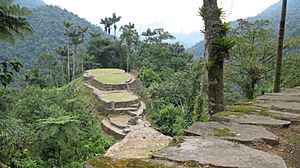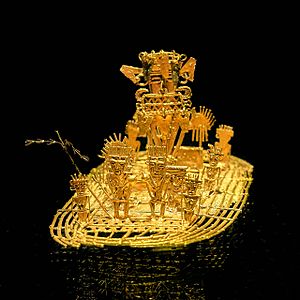Pre-Columbian cultures of Colombia facts for kids
The pre-Columbian cultures of Colombia were the amazing groups of people and civilizations that lived in Colombia long before the Spanish arrived in the 1500s. These ancient cultures created unique ways of life, art, and social systems. They left behind many clues about their lives, from ancient tools to impressive gold artworks.
Contents
Where Did They Live?
Colombia's special location made it a busy pathway for early humans. People migrated through here from places like Mesoamerica (Central America) and the Caribbean islands, heading towards the Andes mountains and the Amazon basin.
The oldest clues about people living here are from places like Pubenza and El Totumo. These clues are super old, from about 18,000 to 8,000 years before Christ (BCE). Later, around 8,000 to 2,000 BCE, people started to settle down more. The oldest pottery in the Americas was found here, dating back to 5,000-4,000 BCE!
By 12,500 BCE, people were definitely living in what is now Colombia. Early groups were mostly hunter-gatherers. They moved around to find food and traded with other groups. Over time, between 5,000 and 1,000 BCE, these groups started to farm. They built fixed homes, and pottery became common.
How Were Societies Organized?
Starting around 1,000 BCE, groups like the Muisca, Zenú, Quimbaya, and Tairona developed special ways of organizing their societies. They had a system called cacicazgos. This meant they had a leader called a cacique (chief) at the top, with other people organized below them.
Most of these groups were farmers. Each community had its own unique social structure. Some groups, like the Caribs, were often at war. Others were more peaceful.
There wasn't one single, huge culture that ruled all of pre-Columbian Colombia. Instead, there were many different groups and smaller cultures. Most of these groups spoke languages from three main families: Arawak, Carib, and Chibcha.
What Did They Create?
These ancient people were very skilled. They learned to grow different crops depending on where they lived:
- Yucca in warmer, lower areas.
- Corn in middle-altitude regions.
- Potatoes in the cooler highlands.
They were also excellent at making pottery and other crafts. They were especially good at working with gold. They even used a special mix of gold and copper called “tumbaga”. This made the gold easier to shape into amazing artworks.
Unlike the Mayas, Aztecs, or Incas, the people of Colombia did not develop a system of writing. They also didn't build huge empires that controlled vast lands. By the year 1500, the most advanced groups were the Taironas and the Muiscas.
Important Ancient Cultures
Many different cultures thrived in pre-Columbian Colombia. Each one had its own special skills and traditions.

San Agustín Culture
The San Agustín culture lived in the upper Magdalena River region, in what is now the Huila Department. They are famous for their giant stone statues. These huge sculptures were made for religious reasons.
Tierradentro Culture
The Tierradentro culture lived in the Cauca Department. They are known for their hypogea. These are amazing underground tombs carved into the earth.
Tumaco Culture
The Tumaco culture was located in southwest Colombia, near the border with Ecuador. They were known for their pottery, especially their detailed sculptures made from clay.
Tolima Culture
The Tolima culture lived in the Tolima Department in central Colombia. They are recognized for their beautiful gold work and pottery.
Nariño Culture
In southwestern Colombia (Nariño Department), the Nariño culture was known for its pottery. They used a special painting style called "negative painting" or "positive bicolor."
Calima Culture
The Calima culture lived in western Colombia (Valle del Cauca). Their location was important because it was a main route between the Pacific Coast and the Cauca River valley. This helped their culture grow, and they became famous for their goldsmithing.
Zenú Culture
The Sinú or Zenú culture was located in northwest Colombia (Sucre Department and Córdoba). They are known for their useful and ceremonial ceramics and gold work. They combined many different techniques in their art. They also built a clever system of drainage channels to control floods.
Quimbaya Culture
The Quimbaya lived in the Cauca River Valley, between the Western and Central mountain ranges of the Colombian Andes. This area includes parts of the Caldas Department, Risaralda Department, and Quindío Department. They are famous for their gold work, including special bottles called poporos. These were used to store lime for chewing coca leaves.
Tairona Culture
The Tairona lived in northern Colombia, in the isolated Sierra Nevada de Santa Marta mountains. This area is now part of the Magdalena Department. They are known for their gold work, pottery, and amazing stone buildings on the mountain slopes, like Ciudad Perdida ("The Lost City").
Muisca Culture
The Muisca lived mainly in the area of what is now Bogotá and the departments of Boyacá and Cundinamarca. They formed the Muisca Confederation, a group of chiefdoms. They were skilled farmers, growing corn, potatoes, quinoa, and cotton. They traded gold, emeralds, blankets, pottery, coca, and especially rock salt with neighboring groups. Among their gold creations, the Tunjos are special. These were human-like figures used for rituals.
See also
 In Spanish: Periodo precolombino en Colombia para niños
In Spanish: Periodo precolombino en Colombia para niños




